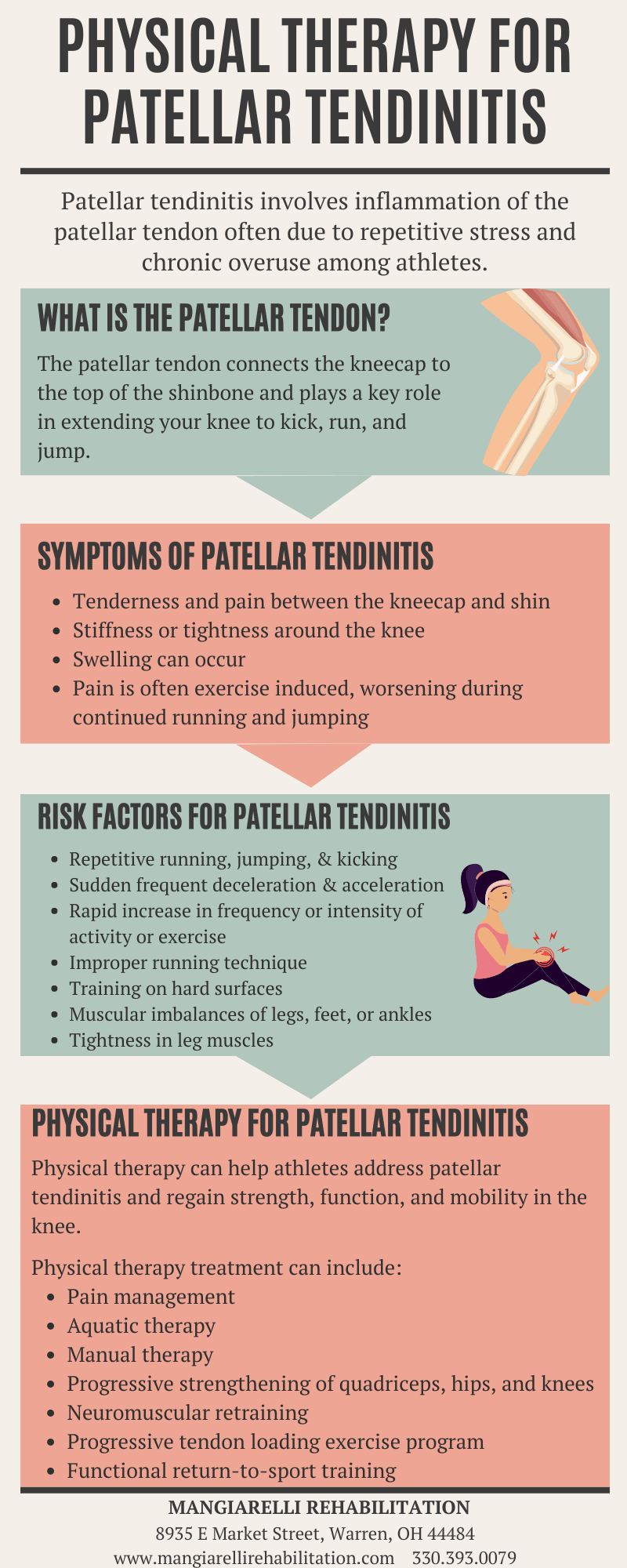Physical Therapy for Patellar Tendinitis Infographic
Patellar tendinitis, or jumper’s knee, involves inflammation of the patellar tendon often due to repetitive stress and chronic overuse of the tendon among athletes. The patellar tendon connects the kneecap to the top of the shinbone and plays a key role in extending the knee to kick, run, and jump.
Patellar tendinitis is an overuse injury due to the mechanical stress placed on the patellar tendon from repetitive jumping, landing, accelerating, decelerating, and cutting. The stress causes microtears in the tendon that contribute to tissue breakdown and an inflammatory response. This leads to pain and tenderness between the kneecap and shin, stiffness or tightness around the knee, and swelling. Pain is often exercise-induced, worsening during continued running or jumping.
Patellar tendinitis is common among basketball, volleyball, and soccer players as well as dancers and heavy weightlifters due to the repetitive jumping, landing, and running that these activities and sports require. There are a number of factors that can increase the risk of developing patellar tendinitis:
Repetitive activities (running, jumping, kicking)
Sudden and frequent deceleration and acceleration
Rapid increase in frequency or intensity of activity, exercise, or training
Improper running technique
Training on hard surfaces
Muscular imbalance in leg muscles, feet, or ankles
Ligament laxity in the legs
Quadricep and hamstring tightness
Previous ongoing inflammation of the knee
Physical therapy can help athletes address patellar tendinitis and regain strength, function, and mobility in the knee. Physical therapy treatment for patellar tendinitis can include:
Pain management using ice and rest to reduce inflammation
Aquatic therapy exercises in a warm water therapy pool to reduce stress on the knee joint while engaging in gentle movement to increase mobility and range of motion
Manual therapy soft tissue and joint mobilizations to improve alignment, mobility, and range of motion in the knee
Progressive strengthening of quadriceps, hips, and knees to address muscular imbalances that place too much stress on the patellar tendon
Neuromuscular training to retrain the lower extremity and improve movement techniques and biomechanics, especially when running, squatting, and jumping
Functional retraining to return to sport safely
One key aspect of patellar tendinitis is a progressive tendon loading exercise program and the use of eccentric exercises. Eccentric exercises focus on rebuilding the tendon’s strength and its ability to withstand and bear a load without being overtaxed. Eccentric exercises performed with progressively heavier loads over time have shown excellent results such as decreased pain and structural changes and healing of the patellar tendon over time.
A 2021 study compared eccentric exercises for patellar tendinitis with a progressive tendon loading program. In the study, researchers assessed 76 patients with longstanding patellar tendon pain: half of the participants did eccentric exercises and half did a progressive four-stage tendon loading exercise program. At 24 weeks, both groups did a series of sport-specific exercises before being cleared to return to activity. Interestingly, the progressive tendon loading exercise group had greater improvements and results: the tendon loading exercise group was 56% better in terms of pain improvement and had a higher return to sports rate (43% for the tendon loading group vs. 27% for the eccentric exercise group).
The four-stage progressive loading exercise program involved 1) isometric static exercises like a wall sit, 2) isotonic dynamic exercises like a split squat to further load the quadricep muscles and patellar tendon using both eccentric and concentric muscle actions, 3) explosive plyometric exercises as pain decreases and strength improves, such as squat and split squat jumps, and 4) sport-specific exercises such as running and agility training and single-leg jumps.
To prevent patellar tendinitis, always warm-up and stretch before exercise and cool down post-exercise. Wear knee supports when playing sports like basketball and volleyball and avoid jumping and landing on hard surfaces. Consistently strengthen the leg muscles and ensure proper alignment of the hips, knee, and ankle during activity to reduce stress on the knee and patellar tendon over time.
If you are experiencing patellar tendinitis, come work with a physical therapist to address the condition before it worsens and regain strength and function to return to your sport!
